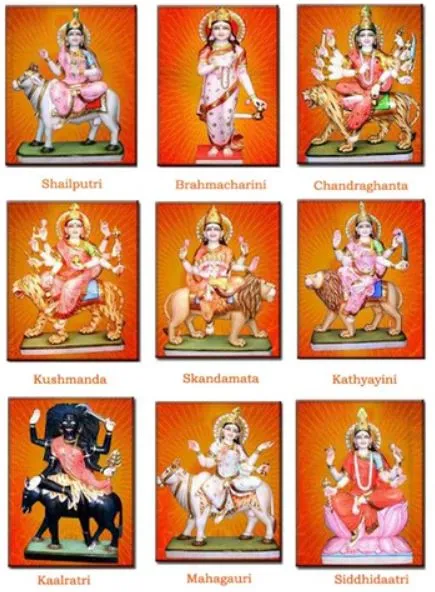Durga Puja and Navratri are deeply connected, and each day is dedicated to one of the nine divine forms of Goddess Durga, known as Navadurga. Worshipping these forms symbolizes different aspects of strength, purity, knowledge, and protection. Here’s a detailed day-wise description:
Day 1 – Shailaputri (Daughter of the Mountain)
- Form: She is depicted riding a bull (Nandi), holding a trident in her right hand and a lotus in her left hand.
- Meaning: Shailaputri means Daughter of the Himalayas. She represents purity and the beginning of spiritual discipline.
- Significance: Worshipping her grants strength, stability, and spiritual awakening.
Day 2 – Brahmacharini (The Ascetic Goddess)
- Form: She holds a rosary (mala) and a kamandalu (water pot), walking barefoot.
- Meaning: Symbol of devotion, penance, and sacrifice.
- Significance: Blesses devotees with wisdom, patience, and determination.
Day 3 – Chandraghanta (Goddess with the Moon Bell)
- Form: She rides a tiger, carries weapons in her ten hands, and wears a crescent moon on her forehead that looks like a bell (ghanta).
- Meaning: Represents bravery and fearlessness.
- Significance: Worship brings courage, protection from evil forces, and relief from pain and troubles.
Day 4 – Kushmanda (The Cosmic Creator)
- Form: She rides a lion, has eight hands carrying weapons, rosary, and nectar. She holds a kamandal and a discus.
- Meaning: Known as the creator of the universe with her radiant smile.
- Significance: Worship brings health, wealth, and strength.
Day 5 – Skandamata (Mother of Skanda / Kartikeya)
- Form: She rides a lion, carries her son Skanda (Kartikeya) in her lap, and has four hands.
- Meaning: Symbol of motherhood, love, and nurturing.
- Significance: Blesses devotees with wisdom, power, and prosperity.
Day 6 – Katyayani (Warrior Goddess)
- Form: She rides a lion, carries a sword, and has four hands. She is fierce and courageous.
- Meaning: Born as the daughter of sage Katyayan, she is the warrior form of Durga.
- Significance: Worshippers receive courage, strength, and success in their endeavors.
Day 7 – Kalaratri (The Dark Night Goddess)
- Form: She has a dark complexion, flowing hair, and rides a donkey. She carries a sword and a deadly iron hook.
- Meaning: Represents destruction of evil and removal of ignorance.
- Significance: Worshipping her removes fear, negative energies, and brings protection.
Day 8 – Mahagauri (The Radiant Goddess)
- Form: She rides a bull, wears white clothes, and has a peaceful, radiant form. She carries a trident and damaru (drum).
- Meaning: Symbol of purity, calmness, and peace.
- Significance: Grants purity of thought, forgiveness, and a peaceful life.
Day 9 – Siddhidatri (Goddess of Supernatural Powers)
- Form: She sits on a lotus, has four arms, and carries a mace, discus, lotus, and conch.
- Meaning: Bestower of Siddhis (spiritual powers) and knowledge.
- Significance: Worshipping her fulfills desires, removes obstacles, and grants success in life and spirituality.
Together, these Navadurga forms represent the complete journey of life – from purity and devotion to power, destruction of evil, and ultimate knowledge.
Significance of Durga Puja
Durga Puja is more than a religious observance; it is a cultural identity, especially for Bengalis. The festival signifies:
-
Victory of good over evil – Symbolizing positivity and righteousness.
-
Women empowerment – Goddess Durga represents Shakti, the divine feminine power.
-
Cultural unity – People from all walks of life join in pandal hopping, enjoying food, dance, and music.
Rituals of Durga Puja
Durga Puja is a five-day celebration, each day marked by special rituals:
-
Shashthi (Sixth Day) – Goddess Durga is welcomed, and eyes are painted on the idol (Chokkhu Daan).
-
Saptami (Seventh Day) – The ritual of Nabapatrika (nine plants) is performed.
-
Ashtami (Eighth Day) – The most sacred day, featuring Sandhi Puja and Kumari Puja.
-
Navami (Ninth Day) – Devotees offer prayers, bhog (holy food), and seek blessings.
-
Dashami (Tenth Day) – Immersion (Visarjan) of the idol takes place, marking the return of the Goddess to her heavenly abode.
How Durga Puja is Celebrated
-
Pandal Hopping: Artistically designed pandals with beautifully crafted idols are the highlight of the festival.
-
Traditional Dance & Music: Dhunuchi Naach, Dhak beats, and cultural programs bring communities together.
-
Food & Feasts: From bhog (khichuri, labra, chutney) to street food like rolls, fish fry, and sweets, Durga Puja is also a foodie’s delight.
-
Immersion Procession: The grand farewell procession of Goddess Durga is an emotional moment, symbolizing renewal and hope.
Life Lessons from Durga Puja
-
Good always triumphs over evil.
-
Unity creates strength.
-
Respect and empower women.
-
Celebrate culture, traditions, and togetherness.
Durga Puja 2025 Dates
-
Mahalaya: 21 September 2025
-
Panchami: 27 September 2025
-
Shashthi: 28 September 2025
-
Saptami: 29 September 2025
-
Ashtami: 30 September 2025
-
Navami: 1 October 2025
-
Vijaya Dashami: 2 October 2025
